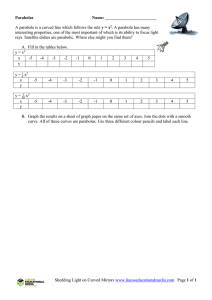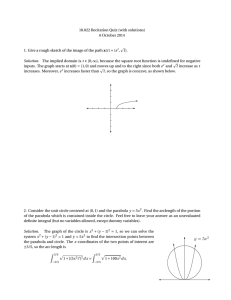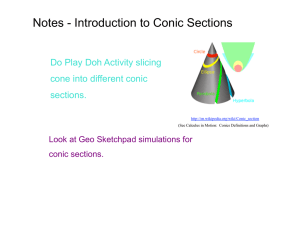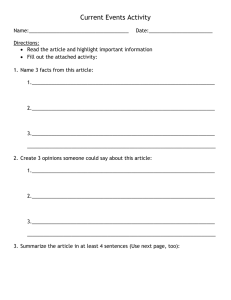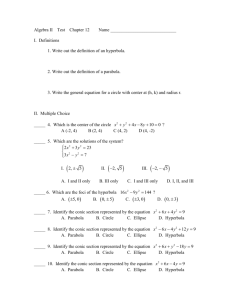Document 14497160
advertisement
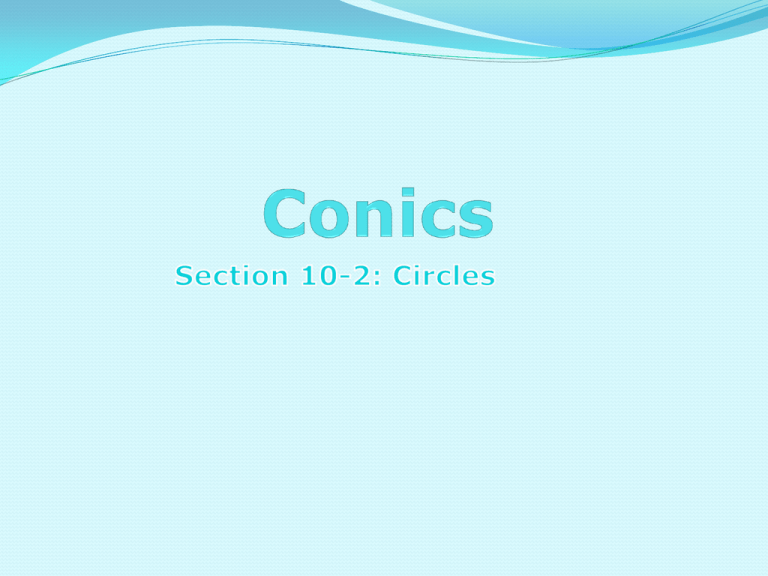
Definition of a circle A circle is the set of all points in the plane that are equidistant from a given point in the plane called the center. The distance from the center to any point on the circle is called the radius. The standard form of the equation of a circle is (x-h) + (y-k) = r where (h,k) is the center of the circle and r is the radius. 2 2 2 A little bit of history A circle is one type of conic section. Conic sections were first studied in ancient Greece sometime between 600 and 300 BC. The Greeks were largely concerned with the properties not the applications of conics. In the 17th century, applications of conics became important in the development of calculus. Ellipses in real life examples Though not so simple as the circle, the ellipse is nevertheless the curve most often "seen" in everyday life. The reason is that every circle, viewed obliquely, appears elliptical. Any cylinder sliced on an angle will reveal an ellipse in cross-section (as seen in the Tycho Brahe Planetarium in Copenhagen). Ellipses in your glass! Tilt a glass of water and the surface of the liquid acquires an elliptical outline. Salami is often cut obliquely to obtain elliptical slices which are larger. Space and ellipses The early Greek astronomers thought that the planets moved in circular orbits about an unmoving earth, since the circle is the simplest mathematical curve. In the 17th century, Johannes Kepler eventually discovered that each planet travels around the sun in an elliptical orbit with the sun at one of its foci. The orbits of the moon and of artificial satellites of the earth are also elliptical as are the paths of comets in permanent orbit around the sun. Halley's Comet takes about 76 years to travel abound our sun. Edmund Halley saw the comet in 1682 and correctly predicted its return in 1759. Although he did not live long enough to see his prediction come true, the comet is named in his honour. On a far smaller scale, the electrons of an atom move in an approximately elliptical orbit with the nucleus at one focus. Properties of ellipses The ellipse has an important property that is used in the reflection of light and sound waves. Any light or signal that starts at one focus will be reflected to the other focus. This principle is used in lithotripsy, a medical procedure for treating kidney stones. The patient is placed in a elliptical tank of water, with the kidney stone at one focus. High-energy shock waves generated at the other focus are concentrated on the stone, pulverizing it. The principle is also used in the construction of "whispering galleries" such as in St. Paul's Cathedral in London. If a person whispers near one focus, he can be heard at the other focus, although he cannot be heard at many places in between. Statuary Hall in the U.S. Capital building is elliptic. It was in this room that John Quincy Adams, while a member of the House of Representatives, discovered this acoustical phenomenon. He situated his desk at a focal point of the elliptical ceiling, easily eavesdropping on the private conversations of other House members located near the other focal point. Parabolas THE PARABOLA One of nature's best known approximations to parabolas is the path taken by a body projected upward and obliquely to the pull of gravity, as in the parabolic trajectory of a golf ball. The friction of air and the pull of gravity will change slightly the projectile's path from that of a true parabola, but in many cases the error is insignificant. This discovery by Galileo in the 17th century made it possible for cannoneers to work out the kind of path a cannonball would travel if it were hurtled through the air at a specific angle. When a baseball is hit into the air, it follows a parabolic path; the center of gravity of a leaping porpoise describes a parabola. The easiest way to visualize the path of a projectile is to observe a waterspout. Each molecule of water follows the same path and, therefore, reveals a picture of the curve. The fountains of the Bellagio Hotel in Las Vegas comprise a parabolic chorus line. Properties of parabolas Parabolas exhibit unusual and useful reflective properties. If a light is placed at the focus of a parabolic mirror (a curved surface formed by rotating a parabola about its axis), the light will be reflected in rays parallel to said axis. In this way a straight beam of light is formed. It is for this reason that parabolic surfaces are used for headlamp reflectors. The bulb is placed at the focus for the high beam and a little above the focus for the low beam. The opposite principle is used in the giant mirrors in reflecting telescopes and in antennas used to collect light and radio waves from outer space: the beam comes toward the parabolic surface and is brought into focus at the focal point. The instrument with the largest single-piece parabolic mirror is the Subaru telescope at the summit of Mauna Kea in Hawaii (effective diameter: 8.2 m). Heat waves, as well as light and sound waves, are reflected to the focal point of a parabolic surface. If a parabolic reflector is turned toward the sun, flammable material placed at the focus may ignite. (The word "focus" comes from the Latin and means fireplace.) A solar furnace produces heat by focusing sunlight by means of a parabolic mirror arrangement. Light is sent to it by set of moveable mirrors computerized to follow the sun during the day. Solar cooking involves a similar use of a parabolic mirror. Two types of images exist in nature: real and virtual. In a real image, the light rays actually come from the image. In a virtual image, they appear to come from the reflected image - but do not. For example, the virtual image of an object in a flat mirror is "inside" the mirror, but light rays do not emanate from there. Real images can form "outside" the system, where emerging light rays cross and are caught as in a Mirage, an arrangement of two concave parabolic mirrors. Mirage's 3-D illusions are similar to the holograms formed by lasers. Hyperbolas A sonic boom shock wave has the shape of a cone, and it intersects the ground in part of a hyperbola. It hits every point on this curve at the same time, so that people in different places along the curve on the ground hear it at the same time. Because the airplane is moving forward, the hyperbolic curve moves forward and eventually the boom can be heard by everyone in its path. A hyperbola revolving around its axis forms a surface called a hyperboloid. The cooling tower of a steam power plant has the shape of a hyperboloid, as does the architecture of the James S. McDonnell Planetarium of the St. Louis Science Center. Properties of hyperbolas Most calculus students have learned of the "reflecting properties" of the parabola and the ellipse. If a "beam of light" emanates from the focus of a parabola in any direction, and is "reflected" from the parabola, it subsequently travels in a line parallel to the axis of the parabola. For the ellipse, a beam emanating from a focus is reflected by the curve through the other focus. Less known is a reflecting property of hyperbolae. A beam of light is directed at one of the foci (with the the curve "between" the source and the focus) then it will be reflected by the curve through the other focus! This property of the hyperbola is used in radio direction finding (since the difference in signals from two towers is constant along hyperbolae), and in the construction of mirrors inside telescopes (to reflect light coming from the parabolic mirror to the eyepiece). Chapter Objectives Now that we have explored conic sections in real life, lets look at each one. At the end of this chapter, we will be able to do the following: 1. Use the standard and general forms of the equations of circles, parabolas, ellipses, and hyperbolas. 2. Graph circles, parabolas, ellipses and hyperbolas. 3. Find the eccentricity of conic sections. 4. Recognize conic sections by their equations. 5. Find parametric equations for conic sections defined by rectangular equations and vice versa. 6. Graph and solve systems of second degree equations and inequalities. The Standard and General Forms of Conics Standard form of conics: circle: (x-h) + (y-k) = r Ellipse: bx hg by kg + 2 2 b2 a2 =1 Parabola: (y-k) = 4p (x-h) bx hg - by k g 2 Hyperbola: a2 (h,k) = center b2 (h,k) = center or (x-h) = 4p ( y-k) 2 = 1 or b g - bx hg yk a2 2 b2 (h,K) = vertex 2 =1 (h,k) = center Rectangular Hyperbola: xy = k General Form of all conics: Ax + Bxy + Cy + Dx + Ey + F = 0 For a circle A=C and B=0 For an ellip se E ith er A or C is zero (W h y can ’t b oth b e zero?) an d B = 0 For a p arab ola A an d C h ave th e sam e sig n , A ≠ C , B = 0 For a hyperbola A and C have opposite signs B=0 For a rectangular hyperbola A=C=D=E=0 The Circle Any situation where a distance is known, but not a direction can be modeled by a circle. Example # 1 : Write the standard form of the equation of the circle that is tangent to the x axis and has its center at (-5,4). Then graph the equation. 2 2 Standard form (x+5) + (y-4) = 16 X -5 4 Example #2 2 2 The equation of a circle is 4x + 4y -24x +16y = -51 1. Write the standard form of the equation 2. Find the radius and the coordinates of the center. 3. Graph the equation. To write the equation in standard form, we need to use our knowledge of completing the square. Step 1: Divide everything through by 4 and we get 2 2 x + y -6x + 4y = 5 1 5 1 2 2 4 (x -6x) + (y +4y) = 4 (x-3) 2 + (y+2) 2 = 5 1 +9+4 =.025 4 Standard form: (x-3) 2 + (y+2) 2 = .25 Radius .5 center (3,-2) Example #3 From geometry, you know that any two points in the coordinate plane determine a unique line. It is also true that any three Noncollinear points in the coordinate plane determine a unique circle. The equation of this circle can be found by substituting the coordinates of the three points into the general form of the equation of a circle and solving the resulting system of three equations. Example: Write the standard form of the equation of the circle that passes through the points at (1,1) (1,2) and (2,3). Then identify the center and the radius of the circle. We have a system of three equations: 2 2 (1) + (1) + D (1) + E (1) + F = 0 2 2 (1) + (2) + D (1) + E (2) + F = 0 2 2 (2) + (3) + D (2) + E (3) + F = 0 D+E+F+2=0 D+2E+F+5=0 2D+3E+F+13=0 D+E+F+2=0 E=-3 D+2E+F+5=0 2D+3E+F+13=0 D+E=-8 D=-5 Therefore F = 9 So the general form of the equation is 2 2 x + y -5x -3y+9=0 Completing the 2square, we have the standard 2 3 5 form as (x- 2 ) + (y- 2 ) = 52 Center (2.5, 1.5) radius 2.5 HW# 14 : Section 10-2 Pp. 627-630 #15-25 odds, 29,35,47
